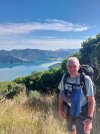Fitness in preparation for Camino is a positive thing to do, but you need to be deliberate about how you proceed. You have enough time to make a significant increase from where you are now, without frantically pushing yourself too hard and beyond your body's ability to recuperate from each exercise session. That same deliberation will help prevent injury as well. Be consistent and patient. If you would like other more specific guidelines and suggestions, send me a PM.

This is a guide I had posted a while back.
-----------------------------
As to training, there are really two different parts to focus on:
1. Cardiovascular fitness.
2. Muscle strengthening.
Cardiovascular fitness is the ability for your heart and lungs to supply oxygenated blood to your muscles during exercise under load, and your muscles ability to use that oxygen efficiently so they can produce energy.
Exercises should be used which will allow you to hit a target heart rate zone, over a for a period of time during exercising, which provides the needed aerobic effort for conditioning. This is a website which will help you calculate what your target heart rate zones will be.
https://www.lifespanfitness.com/fitness/resources/target-heart-rate-calculator
Treadmills at incline, running, walking at a faster than normal pace, walking up hills, rowing machines, HIIT (High Intensity Interval Training) workouts, riding a bicycle at a faster than normal pace, swimming, etc. are all examples of effective aerobic exercises when used to achieve target heart rates.
Keep in mind that as your fitness level improves, it will take a more sustained effort to hit the same heart rate zones. That is why using target zones is so effective. They don't change relative to fitness level. Someone extremely out of shape does not exercise as hard as someone who is extremely fit to reach their target.
Muscle strength is a function of how much maximum force your muscles can exert against resistance. Exercises for strength will
also provide a temporary aerobic effect, but the main goal is to increase your capability to function while under resistance.
Think about having to lift the weight of your body, with a pack, with each step going up the Pyrenees. Or being able to lift and carry a load. Or the constant resistance of your body weight and pack to your shoulders and to the 'core' muscles in your back and abdomen.
Some basic strengthening exercises for home include push-ups, lunges, squats and planks. A google search will show you the way to do these exercises.
Other conditioning issues involve things like ankles, feet, and flexibility. Do a search on this forum for posts about exercises to help prevent shin splints and to help prevent plantars fasciitis.
As your departure date nears and you've been involved in your fitness regimen for the next 6 weeks or so, rather than your routine exercise schedule, put on the clothing and footwear you will be using on Camino, load up your pack, and spend the next several days in a row walking. See how you feel and at what pace you are able to best sustain yourself. That will give you a baseline estimate to calculate logistical issues surrounding the question of how many days it may take to walk your Camino.
More than anything else, enjoy the entire process of getting ready for Camino. Write down your reasons for doing your camino: list your personal goals for doing Camino, and what type of experience you are hoping for. If you become discouraged with your preparations, or feel anxious and overwhelmed, or get a bit of cold feet about leaving home for the camino, or simply to refresh your resolve anew, review what you have written to yourself.
















